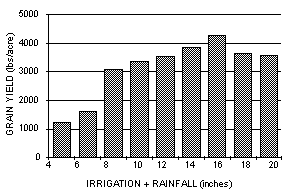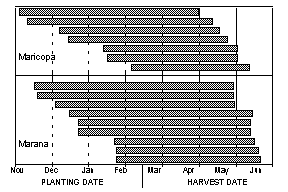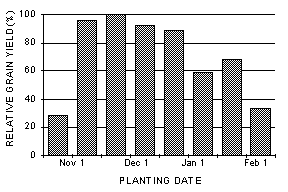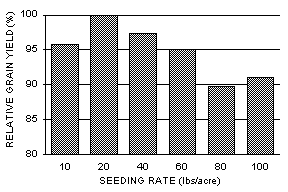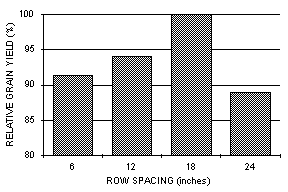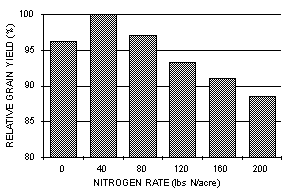Solum Barley
Ottman,
Michael and Stephen H. Husman.
11/94. Solum Barley. Publication number 194030. Cooperative Extension,
College of Agriculture and Life Sciences, University of Arizona, Tucson,
Arizona.
SYNOPSIS
Solum barley was released in 1992 for grain or forage production under reduced water use conditions. Solum has been tested extensively in Maricopa, Pinal, and Pima counties. The adaptation of Solum to other parts of the state is not well known. Solum grain yields can range between 0 and 4000 pounds per acre depending on water availability. Maximum yields are obtained when 12 to 18 inches of water is available from rainfall and irrigation. Excessive water applications cause lodging and decrease yield. Solum should be planted as early as possible to take advantage of winter rainfall but not so early that substantial frost damage occurs. A seeding rate of 20 to 40 pounds of seed per acre is usually sufficient. Solum has yielded best in 18 inch row spacings on experimental plots, but row spacings of 6 or 12 inches are recommended on commercial fields for weed suppression. Solum should be seeded 2 inches deep to promote crown root development or 1 inch deep if surface crusting is expected to hinder emergence. A nitrogen fertilizer rate of 40 pounds of nitrogen per acre is usually sufficient. High nitrogen rates can cause lodging and decrease yields. Phosphorus fertilizer should be applied if the preplant soil phosphorus level is less than 13 ppm P. Irrigation water should be applied near planting and once more near boot for maximum yield.
HISTORY
Solum barley is the result of 18 years of development and testing for low input and reduced water use conditions. The barley breeding program of the ARS, USDA and the University of Arizona initiated this program in 1974. Breeding nurseries were established at the Marana, Mesa, Maricopa, and Campus (Tucson) Agricultural Centers. The barley was grown with a single irrigation near planting time filling the soil profile to a depth of 4 to 6 feet. The term "one-irrigation barley" has been given to lines and cultivars selected under this single irrigation management regime. The only additional moisture was supplied by seasonal rainfall averaging 3 to 4.5 inches. Solum was selected in 1982 and designated '2-22-9'. Solum has since been subject to rigorous testing for 10 years. Solum was released jointly in 1992 by the ARS,USDA and the Universities of Arizona and California.
USES
In Arizona, Solum is intended to be grown with one or two irrigations and supplemental rainfall. Irrigation and rainfall accumulation totaling 12 to 18 inches will meet consumptive use demands (Fig. 1). Solum is also adapted to the dryland barley areas of California where rainfall averages less than 15 inches. Solum is valuable as a rotational crop in Arizona due to its earliness. Solum is usually harvested in late April in Central Arizona if seeded from late November through the first week of December (Fig. 2). Solum is also an excellent source of green manure or forage since it accumulates more growth in the winter than alfalfa or other cereal crops. Solum may also be suited to dryland production in the higher elevation areas in Arizona.
Fig. 1. Dependence of grain yield on irrigation + rainfall derived from two growing seasons at Marana.
Fig. 2. Summary of harvest dates for various planting dates at Marana and Maricopa.
Seco, a reduced water use barley related to Solum, was released in 1987 for the southwestern U.S. Seco was released to control weeds and wind erosion on abandoned farmland, provide feed and forage for wildlife, stabilize soils, and provide ground cover or green manure. The heads and straw of Seco are resistant to breakdown, which is responsible for Seco's superiority as a cover and erosion control crop, but is also responsible for Seco's poor threshability. In addition, the yield potential of Seco is lower than Solum and these varieties should not be confused with each other.
PLANT CHARACTERISTICS
Solum is tall compared to most other commercial barley varieties grown in Arizona, and can attain a height of 40 inches depending on growing conditions. Solum has a tremendous tillering capacity which accounts for its ability to compensate for low plant densities. Solum matures approximately 1 week earlier than WestBred Barcott and 3-4 weeks earlier than WestBred Gustoe. Solum can develop a deep root system depending on soil conditions and deep soil moisture. The deep root system is responsible for its ability to "mine" water and nutrients. Several years of research results has shown Solum grown with one irrigation to have an average test weight of 46 pounds per bushel compared to 55 pounds per bushel for WestBred Gustoe grown with six irrigations. Solum has the ability to fill grain despite lack of water during the grain fill stage. With a single irrigation, Solum had a kernel weight of 32 grams per 1000 compared to 23 grams per 1000 for WestBred Gustoe.
CULTURAL PRACTICES
Planting date: Solum should be planted as early as possible but not so early that substantial frost damage is sustained. Early planting is essential so that winter precipitation is exploited and the crop matures before hot weather begins in spring. In Maricopa, Pinal, and Pima counties the optimum planting period is mid-November through mid-December (Fig. 3). Planting date studies have not been conducted in other parts of the state, but planting as early as is custom in these areas is recommended. Yield loss with delayed planting is almost certain, and is much greater than the slight risk of yield loss due to frost within recommended planting times. Barley is less susceptible to frost damage than wheat. Low seeding rates lessen the likelihood of frost damage since the percentage of heads at the sensitive flowering stage at any given time is less than at high seeding rates.
Fig. 3. Summary of planting date studies conducted at Marana and Maricopa.
Seeding rate: A stand of approximately 4 plants per square foot is necessary for optimum yield. The amount of seed required to achieve this stand depends on seed size, seedbed preparation, and emergence conditions. A seeding rate of 20 to 40 pounds per acre is usually sufficient (Fig. 4), but higher seeding rates may be required to overcome poor seedling emergence. Extremely high seeding rates and high plant populations can result in yield loss. This is possibly due to increased vegetative growth and water use early in the season at the expense of kernel development and growth later in the season. In addition, high plant populations will result in smaller grain heads.
Fig. 4. Summary of seeding rate studies.
Row spacing: Optimum yields of Solum have usually been achieved in row spacings of 18 inches on experimental plots (Fig. 5), but 6 or 12 inch row spacings are recommended for weed suppression. Wide row spacings promote tiller development and conserve soil moisture for critical stages later in the season. Weed control can be a problem in wide row spacings, however. Distance between seeds within row is closer in wide compared to narrow row spacing, and emerging seedlings in close proximity can help each other break through a soil crust. When seeding on beds, two to five rows may be planted on top of the beds. Planting in furrows is probably not worthwhile.
Fig. 5. Summary of row spacing studies.
Seeding depth: Solum barley should be seeded at a depth of 2 inches unless a crust is expected to hinder seedling emergence, in which case a seeding depth of 1 inch is more appropriate. Crusting is likely to occur on certain soil types when planting on flat ground and "irrigating-up" or as the result of rainfall before emergence. Crust formation is not likely on beds. Potential crusting problems are often overcome by shallow planting since the seedlings may emerge before the crust forms. Shallow seeding can decrease yield potential if the surface soil dries during tillering leading to suppressed crown and root development. Deep seeding results in a deeper crown placement than shallow seeding and more time is available for secondary root development before the soil near the crown dries. Seeding depth may not be important in wet years or when multiple irrigations are applied.
Nitrogen fertilizer rate: Solum is not very responsive to nitrogen fertilizer (Fig. 6). High nitrogen rates can promote excessive vegetative growth, encourage lodging, and decrease yields. Some soils do not require nitrogen fertilizer due to nitrogen residual from previous crops. Nitrogen fertilizer is not required after an alfalfa crop. A rate of 40 pounds of nitrogen per acre is usually sufficient for optimum yields of Solum. Nitrogen rates greater than 80 pounds of nitrogen per acre can substantially decrease yields.
Fig. 6. Summary of nitrogen rate studies.
Phosphorus fertilizer rate: The phosphorus fertilizer needs of Solum have not been tested. The optimum phosphorus fertilizer rate for Solum is assumed to be similar to other small grain varieties. Phosphorus fertilizer recommendations for small grains are based on a preplant soil test. A phosphorus rate of 50 to 100 pounds P2O5 per acre is recommended if the soil phosphorus is less than 7 ppm P, 0 to 50 pounds of P2O5 is recommended if the soil phosphorus is between 7 and 13 ppm, and no phosphate fertilizer is recommended if soil phosphorus is greater than 13 ppm P.
Irrigation: Solum should receive an irrigation near planting time either preplant, to germinate the seed, or after emergence. A preplant irrigation followed by planting into moisture is optimum. Solum can also be irrigated up. However, yields may be suppressed in shallow plantings required for irrigating up if the surface dries before the plant can develop an adequate crown and root system. Solum can also be planted in dry soil, germinated by moisture from rainfall, and irrigated after emergence. Some moisture is necessary beneath the seeding depth for the root system of the emerging seedling to develop. A deep establishment irrigation, whether pre- or post-plant, is recommended to enable the plant to develop a deep root system.
Additional irrigations should be adjusted according to winter rainfall in order to meet the optimal total water application of 12 to 18 inches. A second irrigation can be applied near the boot stage to help fill the grain. The second irrigation can be delayed until heading or shortly thereafter in years with ample rainfall. More than two 6-inch irrigations is not recommended for Solum since yields will probably not increase and lodging may result. If less than 6 inches of water can be applied per irrigation, then more than two irrigations may be beneficial, particularly in sandy soils. The soil profile should be moist to a depth of 4 to 6 feet by the initiation of tillering so that root penetration into the subsoil is not hampered. The optimum timing of irrigations after planting depends on rainfall, weather, and growth conditions. Nevertheless, optimum timing of three irrigations is at planting, mid-jointing, and 1 week after heading; four irrigations may be timed at planting, early jointing, boot, and 2 weeks after heading.
Planting on beds or flat ground: The decision to plant on beds or flat ground involves consideration of irrigation capabilities, side-fall, land preparation, and other factors. Yields of Solum planted on beds vs. flat ground have not been tested. Good yields have been obtained with both planting systems. Solum can be planted deep on beds without the same risk of surface crusting as on flat ground. Deep planting ensures adequate crown and root development if the surface soil dries too quickly as mentioned in the Seeding Depth section.
Yield potential: Solum has less yield potential than current commercial varieties when grown under high-yielding conditions. In low water use environments, however, Solum is superior. Yields under dry land conditions with no irrigation may range from 0 to 2000 pounds per acre in the low desert valleys depending on residual soil moisture and season rainfall. Grain yields of 2,000 to 3,000 pounds per acre can be expected with one irrigation. Grain yields of 3,000 to 4,000 pounds per acre can be expected with two irrigations, one near planting and the second near boot.
Grain yield may vary substantially according to location, soil type, planting date, weather, and seasonal rainfall. The amount of available moisture seems to be most important in determining yield. Sources of moisture include residual soil moisture from the previous crop, irrigation, and rainfall. Timing of rainfall can be particularly important.
Issued in furtherance of Cooperative Extension work, acts of May 8 and June 30, 1914, in cooperation with the U.S. Department of Agriculture, James A. Christenson, Director Cooperative Extension, College of Agriculture and Life Sciences, The University of Arizona.
The University of Arizona is an equal opportunity, affirmative action institution. The University does not discriminate on the basis of race, color, religion, sex, national origin, age, disability, veteran status, or sexual orientation in its programs and activities.
Any products, services, or organizations that are
mentioned, shown, or indirectly implied in this web document do not imply
endorsement by The University of Arizona.
Information provided by:
Michael Ottman, mottman@ag.arizona.edu Agronomy Specialist
Steve Husman, husman@ag.arizona.edu Area Agent
College of Agriculture, The University of Arizona.
Material written November 1994.
Home | Other Crops | Grains | Forages
document located at: http://cals.arizona.edu/crops/othercrops/grains/cropmgt/solumbarley.html
Copyright © 2001 University of Arizona,
College of Agriculture and Life Sciences
Webmaster: Al Fournier (acis@ag.arizona.edu)
